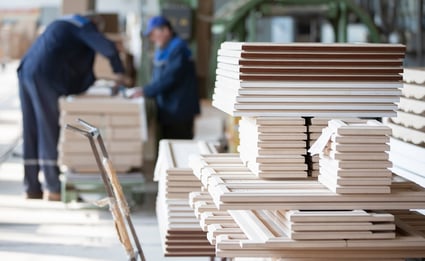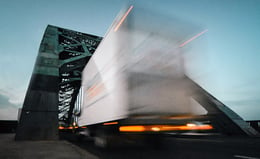5 Unique Challenges in Furniture Logistics
Brian Hoey - June 06, 2019

Anyone who has ever rented a moving van for a day knows how hard it is to move furniture safely and efficiently. Loading a table and chairs into the back of a truck without getting them scuffed up is difficult enough—imagine trying to do the same thing on an industrial scale. But, for many in the furniture industry, moving goods that are designed to spend most of their lives sitting in one place is just a daily fact of life. Unsurprisingly, this tends to come with a lot of challenges that many logistics planners outside the furniture industry don’t have to face.
1. Warehousing… Or Not
Perhaps the biggest difference faced by those in the furniture industry when it comes to moving their products from point a to point b is the way that warehouses are, and aren’t, utilized. For those in the industry who are warehousing significant quantities of stock, the odd shapes and general bulk of many products make this difficult to accomplish in a space-efficient manner—but this is nothing compared to the high wire act that many furniture manufacturers attempt on a daily basis: no warehouse usage at all. Instead of creating a buffer stock of products and shuttling them from factories to warehouses and distribution centers, some furniture makers send their products straight from production lines to trucks. As you can imagine, this presents real challenges for transport planners within these organizations. Why? Because there is essentially no wiggle room when it comes to aligning the timing of production plans with the availability of transport. One moderate delay on either end and you run the risk of your entire production schedule collapsing. The best way to avoid this is to start your planning processes with a high degree of visibility, but even that only staves off so many disruptions.
2. Shipment Scheduling
Because of the nature of production-into-truck workflows, actually scheduling any given shipment of goods can require a lot of precision. Unfortunately, this is made even more complex by the fact that many businesses aren’t simply dropping off their goods at the client’s doorstep and moving on. On the contrary, many furniture producers also offer installation and assembly upon shipment, meaning that the actual drop-off times for shipping routes can be fairly variable. This is hardly insurmountable, but it does mean that in whatever planning workflow you adopt you need to be able to account for those potential time constraints. For many of your potential customers, the stereotype of overly long delivery windows for furniture delivery pervades—but, by accounting for the variables of timing in a more efficient way (i.e. marking particular orders as requiring installation and gaining real-time data from delivery personnel over the course of a given day) you can buck that stereotype and delight your buyers.
3. Efficient Freight Loading
We discussed one of the difficulties of loading in the furniture industry above—the challenge of not damaging any of the goods—but the potential issues run a lot deeper than that. Since many items of furniture are irregularly shaped, loading goods into trucks or containers in an optimal way is easier said than done. This might seem like a small point, but think about it: you’ve got a shipping route all planned out, with individual customer orders mapped onto a set of stops and a particular manifest of items—when you realize that you can’t quite fit all of the goods you need to move into the truck that’s supposed to move them. Do you rearrange the items to try and make more room, potentially causing a significant delay in the process? Or do you abandon part of the shipment and prepare a second, potentially LTL (less-than-full truckload) shipment to deal with the items that don’t fit? Conversely, you might decide that the order containing the leftover items will just have to wait for the next shipment—but you run the risk of that shipment overflowing, and if those items don’t comprise a complete order you’re going to have potentially multiple confused, unhappy customers. Better to do everything possible to avoid this scenario in the first place. How? Well, in a digitally-powered environment, you might start by tracking the dimensions of each item and simulating their placement in a 3D model.
4. Reverse Logistics
Of course, virtually every pitfall that we discussed above comes back into play when we start talking about reverse logistics. It may not be ideal, but it’s a fact of life that sometimes your customers are going to need to send back something that they purchased from you. When that happens, you’re stuck undoing all of the difficult work that went into getting the goods from point a to point b in the first place: avoiding scratches and dings, setting pick-up and transport times with any degree of precision, and finding space to store the stock while it’s repaired, resold, or repurposed. If, however, you were able to operate fairly optimally while moving your goods to their destination in the first place, it’s fairly likely that you’ll be able to do so on the way back as well. Why? Because optimal furniture logistics requires such a high degree of supply chain visibility that reverse engineering the product’s journey isn’t necessarily as difficult and opaque as it could be. This means reduced costs from the reverse logistics end of the equation.
5. Customization
Okay, like the paragraph above, customization isn’t actually unique to the furniture industry. Also like the paragraph above, this an area where all of the existing areas of complexity within the furniture supply chain are intensified. How do you schedule production into trucks when each product has to be customized to order? How can you maintain quick turnaround times for customer orders with potentially variable processes that may have wildly different sourcing requirements? Luckily, if you are utilizing production-into-truck workflows, you’re not relying on a buffer stock and you’re well positioned to adopt a make-to-order process, but the complexity still tends to mount pretty quickly. Luckily, the same sorts of digital processes that we’ve been discussing above can be a big help. If you’re able to visualize each product in terms of the necessary bill of materials, while mapping those materials onto each created order and aligning order creation with transport management, then you can offer customization with a minimum of risk. If not, you might be courting disruption.
If you want to learn more get your Guide to Industry 4.0:
LATEST POSTS
- Understand Circular Economy in The Manufacturing Industry
- How Can Industry 4.0 IT Integration Be Achieved Smoothly?
- The Significance of Order Sequencing in Discrete Manufacturing
- How to improve your Supply Chain Management: The Power of Control Towers
- Optimizing Human Resource Scheduling in Manufacturing: A Technological Approach



